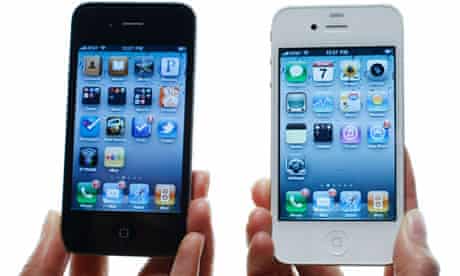Second one. This is a biggie. Something we call the retina display. What's that?
第二項。這可是個重頭。我們稱之為“視網膜屏幕”的一個東西。是什么呢?
Well, in any display there are pixels. Here's four of them.
在任何顯示器上都存在像素。這里有四個。
We start off with the retina display by dramatically increasing the pixel density.
我們從“視網膜屏幕”開始,大幅增加了像素密度。
Four times as many pixels in the same amount of space.
在相同的空間中,像素是原來的四倍。
Now why is that important? Well, let's make more pixels.
為什么這很重要?好吧,讓我們演示一下更多的像素。
And let's say we want to draw the letter A.
假設我們要顯示字母A。
And this is the outside boundary of one of the strokes of the letter, the letter A.
而這是字母A的一個筆劃的外邊界。
While you can see we turn on pixels inside that stroke, we can get far more precision the more pixels we have.
你們可以看到,我們點亮了筆劃內的像素,我們可以得到更高的精度,如果有更多的像素的話。
And we play all sorts of tricks by putting different levels of grey pixels on that line as well to try to fuzz it for our eye.
同時我們運用了各種各樣的小技巧,把不同級別的灰色像素放在那一筆劃上,試圖讓人眼難以分辨。
But when we zoom out of this, what you can see is that because we have four times as many pixels,
但當我們縮小,你會看到,因為我們有四倍的像素,
we get really really sharp text compared to what we normally get on displays of lesser resolution.
與通常分辨率較低的顯示器相比,我們得到的文本會非常清晰。
Now the retina display has 326 pixels per inch.
現在的視網膜屏幕,每英寸有326個像素。
There's never been a display like this on a phone.
這種屏幕是手機上從來沒有過的。
People haven't even dreamed about a display like this on a phone. But it's more than that.
人們甚至做夢都沒想到手機會有這樣的屏幕。但還不止這些。
It turns out that there's a magic number right around 300 pixels per inch,
研究發現,有那么一個神奇的數字,大約每英寸300像素,
that when you hold something around 10 or 12 inches away from your eyes, is the limit of the human retina to differentiate the pixels.
當你拿著這個東西,離眼睛10或12英寸遠的時候,這就是人類視網膜區分像素的極限了。

And so they're so close together when you get at this 300 pixels per inch threshold
所以當你達到每英寸300像素的閾值時,
that all of a sudden things start to look like continuous -- continuous curves like,
突然間它們開始變成像是一條連續的曲線,
text looks like you've seen it in a fine printed book, unlike you've ever seen on an electronic display before.
那些文字看起來就像你是在一本印刷精良的圖書上的著到的一樣,與你以前在電子顯示屏上看到的效果完全不同。
And at 326 pixels per inch we are comfortably over that limit and it's extraordinary.
通過在每英寸上設置326像素,我們平滑地越過了這一限制,這是非常了不起的。
So let me give you an example of a normal display on the left and the retina display on the right.
我給你們舉個例子,左邊是正常屏幕,右邊是視網膜屏幕。
Look at the difference. Can you see it?
看看區別。能看得出來嗎?
Here are some more texts of different sizes and different weights and you can really really see this stuff.
這里有一些不同尺寸和粗細的文字,你可以真切地看到區別。
Once you use a retina display, you can't go back.
一旦你使用了視網膜屏幕,你就回不去了。
When you get the character based languages, Kanji in this case, it's also striking.
當涉及到以單字符為單位的語言時,比如說日文漢字,效果依然無敵。
And it's not just texts, it's images and video as well.
不僅僅是文字,還有圖像和視頻。
Look at the difference. This is the same image on a normal display and a retina display.
看看區別。這是正常屏幕和視網膜屏幕上的同一張圖像。
Here's another one. Pretty amazing, isn't it?
這是另一張。太神奇了,不是嗎?
So what I'd like to do now is show this to you live.
我現在要做的是現場展示給你們看。
I've got an iPhone 3GS which has got a widely praised display on it and I've got a new iPhone 4.
我有一部iPhone 3GS,它的屏幕廣受好評,我還有一部新的iPhone4。
So let me get them both fired up here. There we go.
讓我把他們倆都炒了。就這樣。
And I can ask them to blow these up, there we go. Look at that difference now.
我把它們倆都開啟,好了。現在看看區別。
This is pixel -- we had to get special projectors for this because most projectors can't display as many dots as are on a retina display.
這是像素--我們必須用特殊的投影儀,因為大多數投影儀不能像視網膜屏幕那樣顯示那么多的點。
So this is pixel for pixel accurate right off these two displays and you can really see it.
這就是像素對像素的精確顯示,你們可以看到。
Look at that folder there and then let me go inside and you can look at the icon of the folder, compare them.
看看那個文件夾,然后我點進去,可以看看文件夾的圖標,比較一下。
Look at the texts, look at the linen, look at the icon of the compass, the icon of the clock, isn't that amazing?
看看文字,看看桌面背景,看看指南針的圖標、時鐘的圖標,是不是很神奇?



